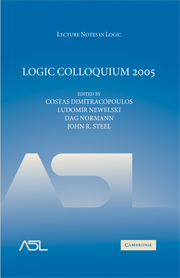Book contents
- Frontmatter
- Contents
- Introduction
- Speakers and Titles
- Thread algebra and risk assessment services
- Covering definable manifolds by open definable subsets
- Isomorphisms and definable relations on computable models
- Independence for types in algebraically closed valued fields
- Simple groups of finite Morley rank
- Towards a logic of type-free modality and truth
- Structural analysis of Aronszajn trees
- Proof analysis in non-classical logics
- Paul Bernays' later philosophy of mathematics
- Proofnets for S5: Sequents and circuits for modal logic
- Recursion on the partial continuous functionals
- A transactional approach to the logic of truth
- On some problems in computable topology
- Monotone inductive definitions and consistency of New Foundations
- LECTURE NOTES IN LOGIC
Proof analysis in non-classical logics
Published online by Cambridge University Press: 18 December 2009
- Frontmatter
- Contents
- Introduction
- Speakers and Titles
- Thread algebra and risk assessment services
- Covering definable manifolds by open definable subsets
- Isomorphisms and definable relations on computable models
- Independence for types in algebraically closed valued fields
- Simple groups of finite Morley rank
- Towards a logic of type-free modality and truth
- Structural analysis of Aronszajn trees
- Proof analysis in non-classical logics
- Paul Bernays' later philosophy of mathematics
- Proofnets for S5: Sequents and circuits for modal logic
- Recursion on the partial continuous functionals
- A transactional approach to the logic of truth
- On some problems in computable topology
- Monotone inductive definitions and consistency of New Foundations
- LECTURE NOTES IN LOGIC
Summary
Introduction. The development of sequent systems for non-classical, in particular, modal, logics, started in the 1950s, with the work of Curry [1952] who provided a system with cut elimination and a decision procedure for S4, and Kanger [1957], who gave sequent calculi and decision procedures for T, S4, S5 with the use of “spotted formulas”, i.e., formulas indexed by natural numbers.
Difficulties in the Gentzen-style formalization of modal logic were, however, encountered at a very elementary level, for instance in the search of an adequate cut-free sequent calculus for the modal logic S5. These difficulties are well witnessed by the ongoing present interest in the problem, with two more proposals presented in this Colloquium (Restall [2005], Stouppa [2005]).
The lack of a general solution has justified an overall pessimistic attitude towards the possibility of applying Gentzen's systems to non-classical logics, as is shown in the following passages:
Gentzen's methods do not provide anything like a universal approach to logic … There are certain standard logics to which these methods do not apply in as direct a fashion … For example, consider the logics B and S5. The Kripke models for these are symmetric … Such things effectively destroy all possibility of a good, simple cut-free Gentzen system.
Fitting (1983, p. 4)The other tradition that should be mentioned is that of proof theory. Gentzen methods have never really flourished in modal logic.
Bull and Segerberg (1984, p. 7)- Type
- Chapter
- Information
- Logic Colloquium 2005 , pp. 107 - 128Publisher: Cambridge University PressPrint publication year: 2007
- 9
- Cited by



